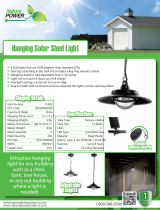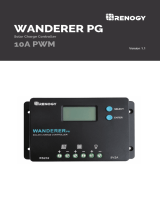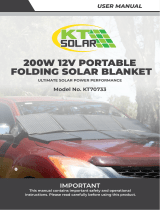
1
The Traveler Series: Wanderer
RENOGY 30A
PWM Charge Controller Manual
2775 E. Philadelphia St., Ontario, CA 91761
1-800-330-8678
Version: 2.5

2
Important Safety Instructions
Please save these instructions.
This manual contains important safety, installation, and operating instructions for the
charge controller. The following symbols are used throughout the manual:
WARNING: Indicates a potentially dangerous condition. Use extreme caution
when performing this task.
CAUTION: Indicates a critical procedure for safe and proper operation of the
controller
NOTE: Indicates a procedure or function that is important to the safe and proper
operation of the controller.
General Safety Information
• Read all of the instructions and cautions in the manual before beginning the
installation.
• There are no serviceable parts for this controller. Do NOT disassemble or attempt
to repair the controller.
• Make sure all connections going into and from the controller are tight. There may
be sparks when making connections, therefore, make sure there are not flammable
materials or gases near installation.
Charge Controller Safety
• NEVER connect the solar panel array to the controller without a battery. Battery
must be connected first. This may cause a dangerous occurrence where the
controller would experience a high open circuit voltage at the terminals.
• Ensure input voltage does not exceed 25 VDC to prevent permanent damage. Use
the Open Circuit (V
oc
) to make sure the voltage does not exceed this value when
connecting panels together in series.
• The charge controller should be installed indoors in a well-ventilated, cool, and dry
environment.
• Do NOT allow water to enter the controller.

3
Battery Safety
• Do NOT let the positive (+) and negative (-) terminals of the battery touch each
other.
• Use only sealed lead-acid, flooded, or gel batteries which must be deep cycle.
• Explosive battery gases may be present while charging. Be certain there is enough
ventilation to release the gases.
• Be careful when working with large lead acid batteries. Wear eye protection and
have fresh water available in case there is contact with the battery acid.
• Over-charging and excessive gas precipitation may damage the battery plates and
activate material shedding on them. Too high of an equalizing charge or too long
of one may cause damage. Please carefully review the specific requirements of
the battery used in the system.
WARNING: Connect battery terminals to the charge controller BEFORE connecting
the solar panel(s) to the charge controller. NEVER connect solar panels to charge
controller until the battery is connected.

4
Table of Contents
General Information......................................................................................................... 5
Optional Components ...................................................................................................... 7
Identification of Parts ....................................................................................................... 7
Installation ....................................................................................................................... 8
Mounting Recommendations ....................................................................................... 8
Wiring .......................................................................................................................... 9
Operation ...................................................................................................................... 11
Setting Battery Type .................................................................................................. 11
LED Indicators ............................................................................................................... 12
System Status Troubleshooting .................................................................................... 13
Maintenance .................................................................................................................. 14
Fusing ........................................................................................................................... 14
Technical Specifications ................................................................................................ 15
Electrical Specifications ............................................................................................. 15
Battery Charging Parameters .................................................................................... 15
Mechanical Specification ........................................................................................... 16
Dimensions ................................................................................................................... 16

5
General Information
The Wanderer is an advanced charge controller for off-grid solar applications. Integrating
highly efficient PWM charging, this controller increases battery life and improved system
performance. It is exclusively designed for 12V battery banks. The controller is embedded
with self-diagnostics and electronic protection functions that prevent damages from
installation mistakes or system faults.
Key Features
• Optimized for 12 VDC system voltage
• 30A charging capacity
• Deep Cycle Sealed, Gel, and Flooded battery option.
• 4 Stage PWM charging: Bulk, Boost. Float, and Equalization
• Temperature compensation and correcting the charging and discharging
parameters automatically, improving battery lifetime.
• Protection against: overcharging, short-circuit, and reverse polarity.
• Negative ground controller
• Remote temperature compensation compatible (accessory sold separately)
PWM Technology
The Wanderer utilizes Pulse Width Modulation (PWM) technology for battery charging.
Battery charging is a current based process so controlling the current will control the
battery voltage. For the most accurate return of capacity, and for the prevention of
excessive gassing pressure, the battery is required to be controlled by specified voltage
regulation set points for Absorption, Float, and Equalization charging stages. The charge
controller uses automatic duty cycle conversion, creating pulses of current to charge the
battery. The duty cycle is proportional to the difference between the sensed battery
voltage and the specified voltage regulation set point. Once the battery reached the
specified voltage range, pulse current charging mode allows the battery to react and
allows for an acceptable rate of charge for the battery level. The Wanderer has a 4-stage
battery charging algorithm for a rapid, efficient, and safe battery charging. They include:
Bulk Charge, Boost Charge, Float Charge, and Equalization.

6
Bulk Charge: This algorithm is used for day to day charging. It uses 100% of available
solar power to recharge the battery and is equivalent to constant current.
Boost Charge: When the battery has charged to the Boost voltage set-point, it undergoes
an absorption stage which is equivalent to constant voltage regulation to prevent heating
and excessive gassing in the battery. The Boost time is 120 minutes.
Float Charge: After Boost Charge, the controller will reduce the battery voltage to a float
voltage set point. Once the battery is fully charged, there will be no more chemical
reactions and all the charge current would turn into heat or gas. Because of this, the
charge controller will reduce the voltage charge to smaller quantity, while lightly charging
the battery. The purpose for this is to offset the power consumption while maintaining a
full battery storage capacity. In the event that a load drawn from the battery exceeds the
charge current, the controller will no longer be able to maintain the battery to a Float set
point and the controller will end the float charge stage and refer back to bulk charging.
Equalization: Is carried out every 28 days of the month. It is intentional overcharging of
the battery for a controlled period of time. Certain types of batteries benefit from periodic
equalizing charge, which can stir the electrolyte, balance battery voltage and complete
chemical reaction. Equalizing charge increases the battery voltage, higher than the
standard complement voltage, which gasifies the battery electrolyte.
WARNING: Once equalization is active in the battery charging, it will not exit this
stage unless there is adequate charging current from the solar panel. There should
be NO load on the batteries when in equalization charging stage.
WARNING: Over-charging and excessive gas precipitation may damage the battery
plates and activate material shedding on them. Too high of equalizing charge or for
too long may cause damage.

7
Optional Components
*The Wanderer is shipped with by itself with no additional components. Optional
components that require a separate purchase:
Remote Temperature Sensor (TS-R): Measures the
temperature at the battery and uses this data for very
accurate temperature compensation. The sensor is supplied
with a 6.6ft cable length that connects to the charge
controller.
Identification of Parts
3
7
7
1
4
5
2
6

8
Key Parts
1. Battery Select Button
2. Battery Select Indicator
3. Battery Indicator
4. PV Indicator
5. Remote Temperature Sensor Adapter (Requires separate purchase)
6. PV Terminals
7. Battery Terminals
Installation
WARNING: Connect battery terminal wires to the charge controller FIRST then
connect the solar panel(s) to the charge controller. NEVER connect solar panel to
charge controller before the battery.
CAUTION: Do not over-torque or over tighten the screw terminals. This could
potentially break the piece that holds the wire to the charge controller.
CAUTION: Refer to the technical specifications for max wire sizes on the
controller and for the maximum amperage going through wires.
Mounting Recommendations
WARNING: Never install the controller in a sealed enclosure with flooded batteries.
Gas can accumulate and there is a risk of explosion.
1. Choose Mounting Location—place the controller on a vertical surface protected
from direct sunlight, high temperatures, and water. Make sure there is good
ventilation.
2. Check for Clearance—verify that there is sufficient room to run wires, as well as
clearance above and below the controller for ventilation. The clearance should be
at least 6 inches (150mm).
3. Mark Holes
4. Drill Holes
NOTE: The Wanderer is not equipped with screws for wall mounting.
5. Secure the charge controller.

9
Wiring
1. Unscrew battery terminals and connect battery connections

10
2. Unscrew PV terminals and connect PV connections

11
3. Insert temperature sensor block terminal and connect wires
(POLARITY SENSITIVITY DOES NOT MATTER)
Operation
After connecting the battery to the charge controller, the controller will turn on
automatically. Operation of this controller is very simply. Users set the battery type, and
leave the rest of the work to the charge controller.
Setting Battery Type
Simply hold the gray button for approximately 7 seconds until the LED flashes. Once
flashing, then press the gray button again to the desired battery type (they are color

12
coded) and simply leave the controller alone until the flashing stops (this should take
approximately 10 seconds). This indicates the parameter has been set.
NOTE: If the LED lights do not flash, hold the gray button for 7 seconds again,
release, and immediately press the gray button again to enable the flashing
LED Indicators
The Wanderer is a simple to use controller requiring little to no maintenance. Users can
be informed about the charge controller’s status based on the LED indicators at the PV
and Battery levels. The following chart goes into further detail regarding the Wanderer’s
indicators.
PV Indicator
BATT Indicator
Controller Status
Fast
Flashing
n/a
PV terminal is over-voltage
Solid
n/a
PV terminal low output
Slow
Flashing
Solid
Battery is charging normally
Slow
Flashing
Slow
Flashing
The battery is in float charge
n/a
Fast
Flashing
The battery is over-voltage
n/a
Solid
The battery is under-voltage
n/a
Solid
The battery is over-discharged
n/a
Slow
Flashing
The battery is over-heating
Set Battery Type
Sealed
Gel
Flooded

13
System Status Troubleshooting
Description
Troubleshoot
Battery is low-voltage
Use a multi-meter to verify the rated battery voltage.
Disconnect any loads connected to the battery to allow it to
charge.
Battery is over-voltage
Use a multi-meter to check the voltage of the battery. Make
sure the battery voltage is not exceeding the rated
specification of the charge controller. Disconnect battery.
PV is over-voltage
Use a multi-meter to check the voltage of the panels. Ensure
that they meet the specification of the controller to not
exceed 25 VDC.
PV terminal low output
The PV output is typically lower in the early mornings and in
the late afternoons. This should not require troubleshooting
unless a solar panel is defective.
Battery is over-heating
When heat is exceeding the specification of the controller, it
will automatically shut down. The controller will resume to
operate once it interprets a change in temperature.
Other Considerations
Charge controller does
not charge during
daytime when the sun
is shining on the solar
panels.
Confirm that there is a tight and correct connection from the
battery bank to the charge controller and the solar panels to
the charge controller. Use a multi-meter to check if the
polarity of the solar modules have been reversed on the
charge controller’s solar terminals.
No LED indicator when
battery is connected to
the charge controller
The battery voltage may be less than 9V. A minimum of 9V
is required to power on the controller.
Battery LED light does
not flash when holding
for 7 seconds.
The battery selection LED must be enabled. Disconnect the
battery from the controller, then connect the battery to the
controller to reset it. Then hold the gray button for 7
seconds, release the button, and then immediately press the
gray button one more time to select a battery type.

14
Maintenance
For best controller performance, it is recommended that these tasks be performed from
time to time.
1. Check that controller is mounted in a clean, dry, and ventilated area.
2. Check wiring going into the charge controller and make sure there is no wire
damage or wear.
3. Tighten all terminals and inspect any loose, broken, or burnt up connections
Fusing
Fusing is a recommendation in PV systems to provide a safety measure for connections
going from panel to controller and controller to battery. Remember to always use the
recommended wire gauge size based on the PV system and the controller.
NEC Maximum Current for different Copper Wire Sizes
AWG
16
14
12
10
8
6
4
2
0
Max.
Current
10A
15A
20A
30A
55A
75A
95A
130A
170A
Fuse from Controller to Battery
Controller to Battery Fuse = Current Rating of Charge Controller
Ex. 30A Wanderer = 30A fuse from Controller to Battery
Fuse from Solar Panel(s) to Controller
Ex. 200W; 2 X 100 W panels
Parallel
Total Amperage = I
sc1
+ I
sc2
= (5.75A + 5.75A) * 1.56
Fuse = minimum of 11.5 * 1.56 = 17.94 = 18A fuse

15
Technical Specifications
Electrical Specifications
Description
Parameter
Nominal Voltage
12 VDC
Rated Charge Current
30A
Max. PV Input Voltage
25 VDC
Self-Consumption
<10mA
High Voltage Disconnect
16V
Over-Voltage Reconnect
15V
Under Voltage Warning
12V
Charging Limit Voltage
≤15V
Equalization Voltage
Sealed:14.6V; Flooded: 14.8V; Gel: NO
Boost Voltage
Sealed: 14.4V; Flooded: 14.6V; Gel: 14.2V
Float Voltage
13.8V
Equalize Duration
120 min
Boost Duration
120 min
Battery Charging Parameters
Battery
GEL
SEALED
FLOODED
High Voltage
Disconnect
16 V
16 V
16 V
Charging Limit
Voltage
15.5 V
15.5 V
15.5 V
Over Voltage
Reconnect
15 V
15 V
15 V
Equalization Voltage
-----
14.6 V
15.5 V
Boost Voltage
14.2 V
14.4 V
14.8 V
Float Voltage
13.8 V
13.8 V
13.2 V
Boost Return Voltage
13.2 V
13.2 V
13.2 V
Under Voltage
Warning
12 V
12 V
12 V
Equalization Duration
-----
2 hours
2 hours
Boost Duration
2 hours
2 hours
2 hours

16
Mechanical Specification
Description
Parameter
Temperature Compensation
-3mV/°C/2V
Working Temperature
-30°C—45°C / -20°F—113°F
Storage Temperature
-35°C—80°C / -31°F—176°F
Max Gauge Size
Up to #8AWG
Weight
0.29 kg / 0.65 lbs.
Dimensions
163.83 x 109.62 x 44.7mm
6.45 x 4.31 x 1.76in
Enclosure
IP20
Dimensions
Renogy reserves the right to change the contents of this manual without notice.
For the most up to date manual, visit our download page at www.renogy.com
Revision: 9/19/2017
-
 1
1
-
 2
2
-
 3
3
-
 4
4
-
 5
5
-
 6
6
-
 7
7
-
 8
8
-
 9
9
-
 10
10
-
 11
11
-
 12
12
-
 13
13
-
 14
14
-
 15
15
-
 16
16
Renogy KIT-STARTER-100D User manual
- Type
- User manual
- This manual is also suitable for
Ask a question and I''ll find the answer in the document
Finding information in a document is now easier with AI
Related papers
-
Renogy RNG-KIT-STARTER200D-WND30 User manual
-
Renogy RNG-KIT-STARTER200D-WND30 User manual
-
Renogy CTRL-PWM20DB User manual
-
Renogy RNG-CTRL-CMD60 User manual
-
Renogy STARTER200DR20 User manual
-
Renogy CTRL-ADV30 User manual
-
Renogy KIT-STCS-100D User manual
-
Renogy RNG-CTRL-VOY20-TS User manual
-
Renogy RNG-CTRL-VOY20 User guide
-
Renogy STCSLW-50MB-NC User manual
Other documents
-
Falcon SP100DV2 Quick start guide
-
 Nature Power 21030 Specification
Nature Power 21030 Specification
-
 HQST 50W Polycrystalline Solar Panel Kit User manual
HQST 50W Polycrystalline Solar Panel Kit User manual
-
Nissei PS30SWI User manual
-
Nissei PS30SWI User manual
-
 KT SOLAR KT70733 User manual
KT SOLAR KT70733 User manual
-
Grape Solar GS-MPPT-ZENITH-20 Operating instructions
-
Epever XTRA3415N User manual
-
Nature Power 60032 User manual
-
Nature Power 60032 User manual


















